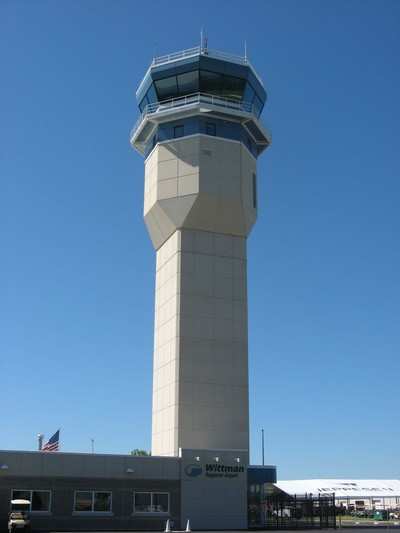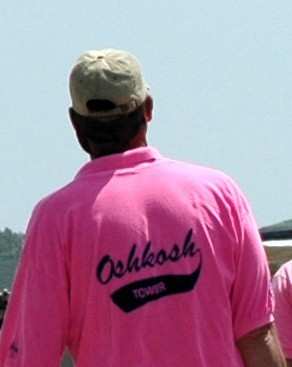Former Controller Shares Insights Into Selection, Duties
by ANN Correspondent Dave Slosson
As a former AirVenture controller, I’d like to share how
the controllers are selected, assigned to teams, trained, and work
AirVenture.

A bid for volunteers goes out to every terminal facility in the
Central Terminal Service Area in early December. The Central
Terminal Service Area is the states in the center of the country,
from Minnesota to Texas and Ohio to New Mexico. Controllers from
these facilities bid to work this special event, and their bid must
be sent by the end of December.
Selection is announced in late January based on AirVenture
experience level, the staffing of the releasing facility during
prime vacation time, seniority, and managerial recommendation. This
year, 172 volunteers were trimmed to 78 selectees: 63 controllers
plus one Sun ‘n Fun controller, 12 front line managers, and 2
operations managers. Additional personnel, not selected from bids,
are the Oshkosh tower controllers, a Quality Assurance specialist,
an administrative support person, and the tower manager.
-
A list of personnel and their facilities for this year’s
AirVenture is available here.
Once the personnel are selected, the 16 teams are assigned. The
team leaders are selected based on previous year’s
observations by the management team and their recommendations on
leadership ability. The rest of the team is chosen based on their
years of service at Oshkosh, whether they volunteered to work
credit hours during the show and previous year’s groupings.
Team leaders have to have at least 3 years of prior experience at
AirVenture, and there is one other veteran on the team (also 3
years experience or more), one limited (1 or 2 years experience)
and one rookie. These teams work together for the entire week,
rotating where they work each day.

The other 51 weeks of the year, Oshkosh tower is not staffed by
FAA controllers, but contract controllers. During AirVenture, these
contract controllers take weather observations, work ground control
and flight data/clearance delivery positions. They are valuable
resources to the FAA teams during AirVenture for equipment
operation help and local knowledge.
The positions the FAA controllers fill at Oshkosh are: north
local, in charge of Runway 9/27 arrivals; south local, in charge of
Runway 18/36 arrivals; Runway 9/27 MOOCOW (MObile Operating and
COmmunications Workstation) in charge of departures; and Runway
18/36 MOOCOW in charge of departures on the associated
runway(s).
Away from Oshkosh, the FAA controllers operate Fisk, the VFR
arrival point, and the Fond du Lac temporary tower. Front line
managers oversee the team’s operations and coordinate IFR
arrivals with north and south local, and IFR departures with the
two MOOCOWs. The operations managers are in charge of coordination
with the various EAA and FAA entities throughout the area, as well
as law enforcement and emergency services, if needed.
Training for AirVenture is quite different than a regular tower.
At most towers, a new controller spends a week or two learning the
area via maps, studying the approach procedures, and having each
position’s operation explained to them by a staff specialist
or assigned trainer. Each piece of equipment is demonstrated and
the trainee gets some hands-on time until they feel comfortable.
All the basics of operating each position have been taught by going
through the Mike Monroney Aeronautical Center training in Oklahoma
City, so once at the facility, on-the-job training is conducted by
a trainer who is also plugged into each position and has immediate
override capability. As training hours build up, a controller feels
much more at ease working each position until they are able to go
solo, so to speak. It is not unusual to spend many weeks, or even
months, learning to work each position until proficient.

At AirVenture, however, all the controllers are already
experienced tower controllers... so the basics of operating
equipment and working positions such as local control are
understood. The differences are explained for all to learn. A
training manual is mailed out in May, which spells out the
procedures in and around Oshkosh, Fond du Lac procedures,
terminology unique to AirVenture, coordination with other entities
in the area, and emergency notification information. There is also
online training to help with aircraft recognition and learning the
NOTAM. The front line managers and operations managers arrive
Wednesday and the controllers arrive on Thursday. They all undergo
a full day of training on Friday in the museum theater, explaining
the training materials in more depth with specific examples. At the
end of the day, all have to pass a written test to be certified
Control Tower Operators at Oshkosh.
 Starting Saturday, the team leaders and the front line managers
help train the limiteds and rookies on the nuances of each position
using show-and-tell methods. All team members on each local
position monitor the radio transmissions so all are part of the
operation of the position. One person talks on the radio while the
others spot the arrivals and give instructions that the talker
repeats. On the MOOCOWs, one person talks to the pilots and the
coordinator both hears the radio transmissions and coordinates with
the other two team members and the tower. At Fisk, one crew member
talks and the others help spot the approaching aircraft and call
out color and type. The training process gets even the rookies up
to speed quickly and efficiently. The teams quickly learn to trust
each other and gel into coherent and efficient aircraft-moving
machines.
Starting Saturday, the team leaders and the front line managers
help train the limiteds and rookies on the nuances of each position
using show-and-tell methods. All team members on each local
position monitor the radio transmissions so all are part of the
operation of the position. One person talks on the radio while the
others spot the arrivals and give instructions that the talker
repeats. On the MOOCOWs, one person talks to the pilots and the
coordinator both hears the radio transmissions and coordinates with
the other two team members and the tower. At Fisk, one crew member
talks and the others help spot the approaching aircraft and call
out color and type. The training process gets even the rookies up
to speed quickly and efficiently. The teams quickly learn to trust
each other and gel into coherent and efficient aircraft-moving
machines.
Take it from one who worked AirVenture for five years... this is
NOTHING like a standard tower operation, not with two teams
controlling each runway simultaneously. A dedicated team of
controllers uses visual methods, not radar, to feed the runway
arrival streams. It’s also quite different than any other
tower because the pilots rarely talk. There is no time to get radio
acknowledgement with this volume of traffic, so the controllers
talk and the pilots listen and acknowledge by rocking their
wings.
Oh, and about those gaudy fluorescent pink shirts? The bright
color the controllers wear serve two purposes. Mostly,
they’re for visibility and safety when they’re working
in and around the MOOCOWs in close proximity to operating aircraft.
The other reason is to help the managers spot the teams on the
field from the tower so they know where their teams are at all
times.
So now that you know about the bidding process, team
assignments, and the training differences, I hope you can really
appreciate the dedication and professionalism of the controllers
working at EAA AirVenture. For one week, they move more traffic
than either Atlanta or Chicago O’Hare, in much closer
quarters and with a lot less training. So when you hear the
pink-shirted folk accidentally identify themselves from their home
airport, smile and know they’re on temporary duty at Oshkosh
because they volunteered to work the most unique, high-volume
aviation event in the country, EAA AirVenture.
Our thanks to Susan Parson, Flight Standards Division, and
Wanda Adelman, Milwaukee tower manager and Oshkosh tower manager
during AirVenture, for contributing to this article.
 ANN's Daily Aero-Linx (04.15.24)
ANN's Daily Aero-Linx (04.15.24) Classic Aero-TV: 'No Other Options' -- The Israeli Air Force's Danny Shapira
Classic Aero-TV: 'No Other Options' -- The Israeli Air Force's Danny Shapira Aero-News: Quote of the Day (04.15.24)
Aero-News: Quote of the Day (04.15.24) Airborne 04.16.24: RV Update, Affordable Flying Expo, Diamond Lil
Airborne 04.16.24: RV Update, Affordable Flying Expo, Diamond Lil ANN's Daily Aero-Term (04.16.24): Chart Supplement US
ANN's Daily Aero-Term (04.16.24): Chart Supplement US






